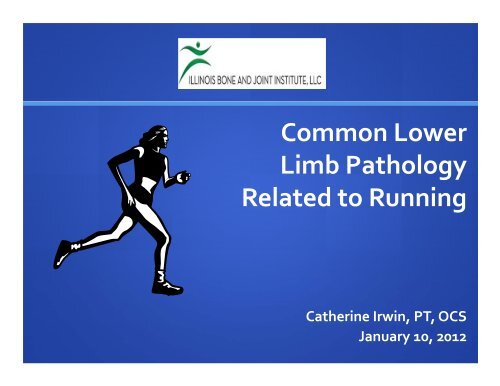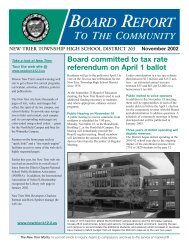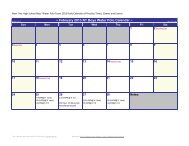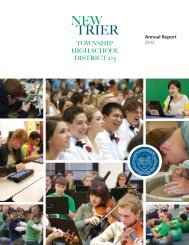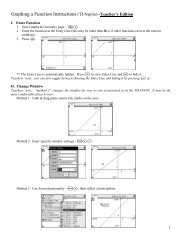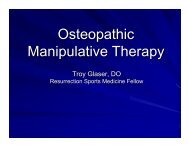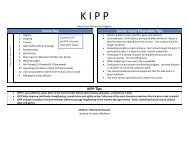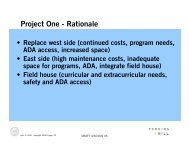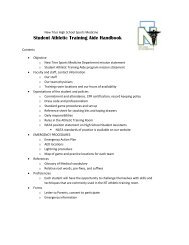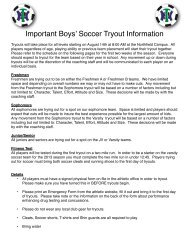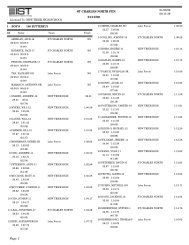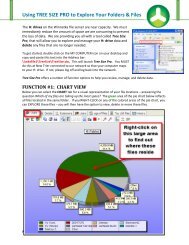Common Lower Limb Pathology Related to Running
Common Lower Limb Pathology Related to Running
Common Lower Limb Pathology Related to Running
You also want an ePaper? Increase the reach of your titles
YUMPU automatically turns print PDFs into web optimized ePapers that Google loves.
Shin Splints• Decreased flexibility in posterior musculature• Increased Tibial Varum• Excessive compensa<strong>to</strong>ry pronation• Training errors/start of spring sports• Hard running surfaces• Large angle of inclination at foot contact
Treatment for Shin Splints• Change running form: Increase cadence, bring foot under themfor contact• Incline running <strong>to</strong> decrease the angle of inclination and promotea mid or forefoot contact• Decreased center of mass displacement/increased knee flexion• Soft landing• Stretch posterior muscles, esp. soleus• Supinate for the stretch/support the arch• Anterior Tibialis stretch
Anterior Tibialis Stretch
Posterior Tibialis Tendonitis• Poor eccentric control of Posterior Tibialis• Accessory navicular/pronated foot• Pain with Single limb heel raise• Tender along pathway of PTT, esp. posterior <strong>to</strong> Medialmalleolus• More severe will have pain in<strong>to</strong> the medial arch• Poor dynamic single limb squat• Pain increases with activity
Treatment for PTT• Taping• Orthotic• Change current shoe (light or mid stability)• Eccentric Control for PTT• Soleus/Gastroc flexibility (stretch with STN <strong>to</strong> avoidstressing the tendon medially)
Single Leg Stance with Trunk Rotation
Single Leg Stance with D2
Calf Stretch with STN
Achilles <strong>Pathology</strong>• Training Errors: Hills/mileage• Improper Shoewear• Decreased extensibility of posterior leg muscles• Excessive Pronation• Ballas et al. 1998, Am Family Physician• Pronation late in stance produces a proximal and distal stress <strong>to</strong>the Achilles tendon and is a primary cause of Achilles tendonitis
Achilles Tendonopathy• Tendonitis/Tendonosis/Severs• If chronic in nature, tendonosis (tendon changes) vs tendonitis(sheath injury)• 2‐6 cm proximal <strong>to</strong> insertion• Pain worse in am and after exercise• Palpate for nodule• Positive squeeze test• Measure width of tendon
Insertional Achilles Tendonitis/Severs• Severs: 10‐14 years of age; growth plate issue• Worse with any shoes pressing against the surface• Tends <strong>to</strong> be chronic and constant in nature• Very sensitive <strong>to</strong> <strong>to</strong>uch• 17‐18 year old runners: Check for Haglunds that is formedfrom the abrasion of the tendon on the bone
Treatment• <strong>Running</strong> Mechanics: Increase cadence <strong>to</strong> get more knee flexion,• Eccentric heel raises 3 X 15, twelve weeks• Gentle CFM/Gentle stretching• Taping <strong>to</strong> off load medial tissue• Orthotic <strong>to</strong> control excessive pronation and stress on medial tendon• Joint mobilizations <strong>to</strong> the TC and STJ if limited DF• Heel lift for tendonitis/heel cup for severs• CAM boot <strong>to</strong> decrease the stress on the insertion
Plantar Fasciitis• Does not usually occur in the under 25 population• Is a connective tissue dysfunction, not just heel pain• Symp<strong>to</strong>ms: 1 st step versus continued walking• Most likely Severs Disease• Cannot strengthen the fascia• Growth Plate
Growth Plate
Patellofemoral Pain• Faulty running mechanics: Foot contact out in front ofCOM; landing in knee extension• Tight Posterior Musculature• Tight ITB• Excessive foot pronation at Mid‐stance• Poor Eccentric control of LE during dynamic activities
Treatment• Stretching• Patellofemoral Tape• Increase cadence: Foot contact under them, decreasebraking impulse and impact• Softer landing
Stress FracturesDeath sentence for a runnerOver trainingHave <strong>to</strong> get them <strong>to</strong> restChange cadence when they return <strong>to</strong> running/incline running<strong>to</strong> get decrease load through the LEOrthotics
Exercises for Dynamic control• Clams• Eccentric Abduction• Single leg squat• AR/AMR/ALR (can use arms or legs for reach)• Medius band walks• S<strong>to</strong>rks• Anterior step down (dips)
S<strong>to</strong>rk, Hip Abduction Eccentric
Sidelying Clams
Medius Band Walk
Single Leg Squat/ Anterior Step Dips
THANK YOU !


